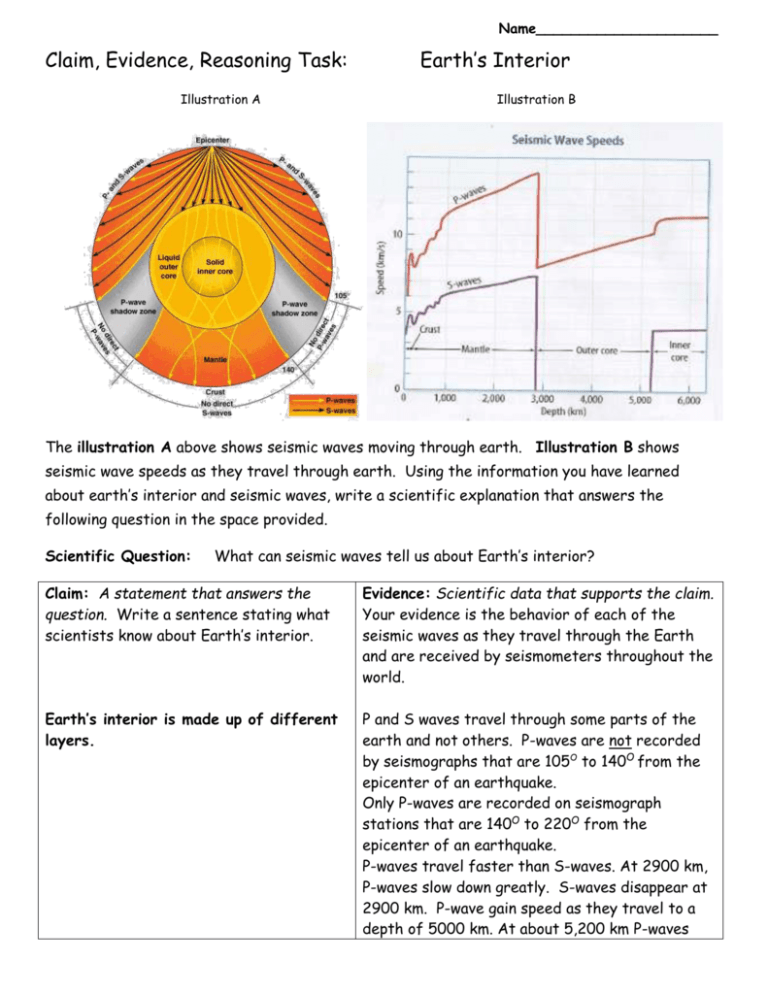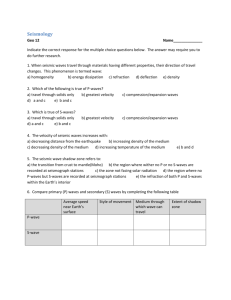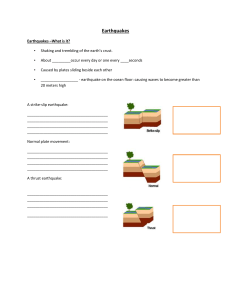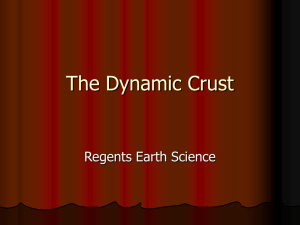CER Task: Seismic Waves & Earth`s Interior
advertisement

Name_____________________ Claim, Evidence, Reasoning Task: Illustration A ______ Earth’s Interior Illustration B The illustration A above shows seismic waves moving through earth. Illustration B shows seismic wave speeds as they travel through earth. Using the information you have learned about earth’s interior and seismic waves, write a scientific explanation that answers the following question in the space provided. Scientific Question: What can seismic waves tell us about Earth’s interior? Claim: A statement that answers the question. Write a sentence stating what scientists know about Earth’s interior. Evidence: Scientific data that supports the claim. Your evidence is the behavior of each of the seismic waves as they travel through the Earth and are received by seismometers throughout the world. Earth’s interior is made up of different layers. P and S waves travel through some parts of the earth and not others. P-waves are not recorded by seismographs that are 105O to 140O from the epicenter of an earthquake. Only P-waves are recorded on seismograph stations that are 140O to 220O from the epicenter of an earthquake. P-waves travel faster than S-waves. At 2900 km, P-waves slow down greatly. S-waves disappear at 2900 km. P-wave gain speed as they travel to a depth of 5000 km. At about 5,200 km P-waves change direction and speed up more. S-wave reappears at a depth of 5200Km and Pwaves speed increases at this depth. Reasoning: A justification that connects the evidence to the claim. Think about what happens to waves as they travel through different media. Since waves are refracted as they move through different media of different densities, the seismic wave data clearly shows that there are layers within the earth at different depths. Pwaves slow down greatly at a depth of 2900 Km and S-waves disappear totally, the wave must have traveled through a medium of less density. S-waves only travel through solids, and can’t travel through liquids. One can infer that the boundary at around 2900 Km deep is a liquid layer. P-waves can travel through solid, liquids, and gases, but the change in phase of the medium will affect the waves speed as it travels. The denser the medium the faster the wave will travel. The layer may be a different composition from the layer above, because differ materials have different densities. When P-waves hit the liquid layer starting at 2900 Km, they are refracted or bent. This explains why seismograph stations 105O to 140O from the epicenter of an earthquake do not receive P-waves. Only P-waves are recorded on seismograph stations that are 140O to 220O from the epicenter of an earthquake because those P-waves traveled through the liquid mantel layer and solid inner core layer. S-waves do not travel through liquid, and so seismograph station located 140O to 220O from the epicenter of the earthquake do not record S-waves. At 5200 Km deep, there is another boundary layer, a change in density. Increase in speed, since S-waves reappear and they only travel in solids, one can assume this boundary layer is solid. 8/8 Distinguished 6 or 7/8 Proficient CER Task: Seismic Waves & Earth’s Interior 5/8 Basic (Emerging) 4 or less/8 Unsatisfactory Claim: A statement that answers the question. Write a sentence stating whether Evidence: Scientific data that supports the claim. Your evidence is the behavior of each of the seismic waves as they travel through the Earth and are received by Reasoning: A justification that connects the evidence to the claim. Think about how waves energy travels through different media. 0 Does not make a claim, or makes an inaccurate claim. 1 Makes an accurate claim but incomplete claim. 2 Makes an accurate and complete claim 3 -- 4 -- Score /2 different seismometers throughout the world. Does not provide evidence, or providence inappropriate evidence (evidence does not support claim). Provides 1 of the following 3 pieces of evidence: May also include inappropriate evidence. Provides 2 of the following 3 pieces of evidence: May also include inappropriate evidence. Provides 3 of the following 3 pieces of evidence: It does not include any inappropriate evidence, but does not include… Provides 3 of the following 3 pieces of evidence: It does not include any inappropriate evidence. /4 Does not provide reasoning or provides reasoning that does not link evidence to claim. Provides inappropriate reasoning. Provides incomplete reasoning that includes 1 or 2 aspects: Provides complete reasoning that includes 2 of 2 aspects: -- -- /2 Much of what is known about the earth’s layers comes from measuring seismic waves caused by earthquakes or massive explosions. As these waves move through different substances, their properties change, allowing scientists to estimate the depths and compositions of different layers of the earth. Scientific understanding of Earth's internal structure is based on observations of topography and bathymetry, observations of rock in outcrop, samples brought to the surface from greater depths by volcanic activity, analysis of the seismic waves that pass through Earth, measurements of the gravity field of Earth, and experiments with crystalline solids at pressures and temperatures characteristic of Earth's deep interior. The layering of Earth has been inferred indirectly using the time of travel of refracted and reflected seismic waves created by earthquakes. The core does not allow shear waves to pass through it, while the speed of travel (seismic velocity) is different in other layers. The changes in seismic velocity between different layers causes refraction owing to Snell's law, like light bending as it passes through a prism. Likewise, reflections are caused by a large increase in seismic velocity and are similar to light reflecting from a mirror. The speeds and paths of seismic waves change as they travel through materials with different densities. Changes is the speeds of seismic waves allow scientists to detect boundaries between earth’s layers. By studying seismic waves that have traveled through the earth, scientists have identified different layers with different densities. In general the densities increase with depth as pressure increases. Studying seismic waves has allowed scientists to map earth’s internal structure without being there. Large areas of earth don’t receive seismic waves from an earthquake. In the area on earth between 105 and 140 from the earthquake focus, no waves are detected. This area, called the shadow zone. Secondary waves are not transmitted through liquid, so they stop when they hit the liquid outer core. Primary waves are slowed and bent but not stopped by liquid outer core. Because of this scientists conclude that the outer core and mantle are made of different materials. Primary waves speed up again as they travel through the solid inner core. The bending of primary waves and the stopping of secondary waves create the shadow zone. Seismic waves bend and change speed as the density of rock changes. Primary waves bend when they contact the outer core, and secondary waves are stopped completely. This creates a shadow zone where no seismic waves are received. The wave's velocity and direction are changed as they travel through different density material.







